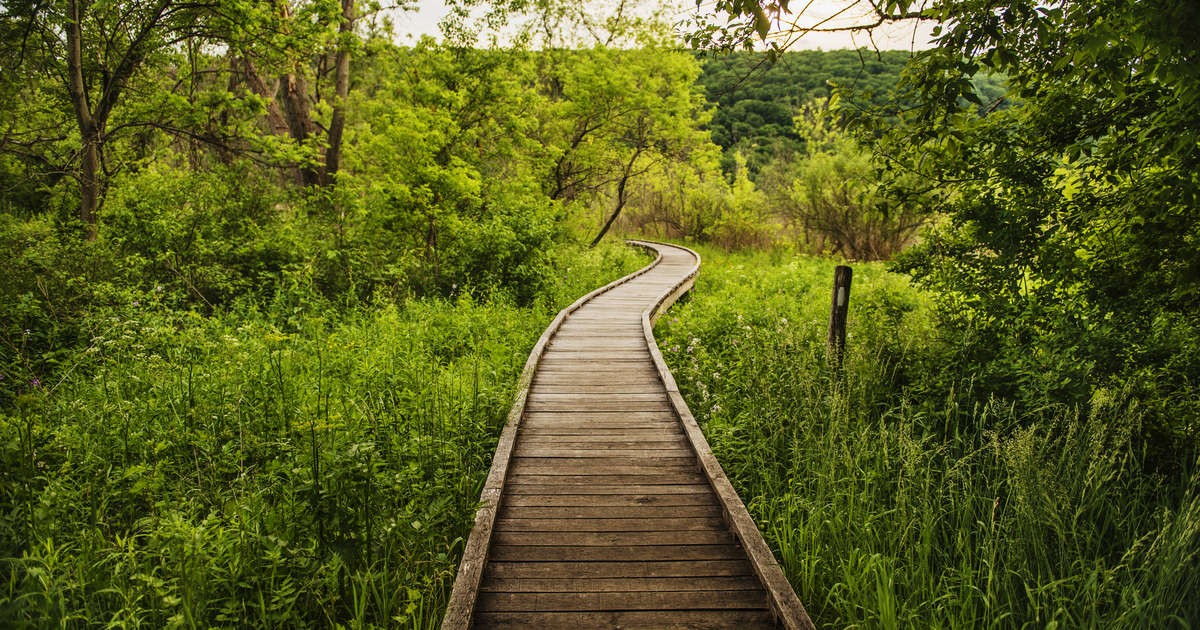
Elements are those considerations which go into the entire Transect. Components of the Transect go well beyond the tread width and type. Elements build upon the ecosystem within each Transect type. Whether there are structures, signs or lighting is dependent upon the Transect chosen. The intensity of these elements play a role in defining the Transect.
The elements of the T1 Transect can be described in one word, native. No construction is seen in a T1 trail as all elements will be native. Surface, plants, alignment, direction, tread, are all native elements. The trail may be formed by animals, or perhaps humans, in an effort to traverse the land for various reasons. T1 is usually an intermittent trail.
The elements of the T2 transit can be described as natural. No change or construction has been implemented to any part of the trail corridor, with the exception of the trail tread itself. There are no changes to native landscape, plants, or rocks. The only element to change is the tread itself, Travel is restricted to the users ability to traverse the grade with it’s naturally occurring obstacles found in the T2 corridor. T2 is a local trail and may not be part of a bigger network as it is yet to evolve to that point.
The T3 network could be described as being the least dense network in the least organized pattern. Trail use is restricted to highly mobile users as numerous obstacles and changes in the surface dominate the network throughout. Rocks, plants, topographical variation, determine the alignment and direction. In T3, native vegetation is largely left in place with a few plants having been relocated out of the trail corridor to their native nearby surroundings. Rocks may be used to control drainage and erosion in the area along the trail corridor. Otherwise the landscape is largely undisturbed. Minor water crossings are accomplished using water bars constructed of native materials, usually rocks or logs. T3 most often contains signage in a consistent pattern.
The T4 Transect is a large step forward in terms of constructing the trail corridor. The trail tread is constructed using a mix of native and non-native sources. The surface is often compacted and consistent. Unlike the T3 Transect, the use of the T4 is mixed, but consistent in its character, which allows all whether usage for bicycles, strollers, wheelchairs, pedestrians, dog walkers, etc. In the T4, the tread width is designed for bi-directional travel at all times, in all places, allowing for users to pass each other without leaving the tread surface. T4 is likely ADA compliant. The USDA Forest Service has developed an excellent guide for this. Non-native vegetation may be used in a limited application to create social spaces. These may be micro parks or taking advantage of a natural amphitheater in which it is evident people will want to stop and enjoy the place. The surface, while all weather, it is not hard. It is not paved. Water crossings are constructed crossings using native or historic materials. The Rails to Trails movement would fit within the upper T4 zone. T4 should contain signage in a consistent pattern.
T5 Transect is the beginning of the Urban Trail Transect where all surfaces are paved. Typically this is with asphalt at a width that allows continuous use in both directions. The T5 Transect always includes navigational signage to notable or important locations nearby. The T5 should be usable by all users, including small children, elderly users in wheelchairs or bicycles, and strollers. Adjacent landscape may incorporate both native plants native rocks topography along with landscape design in many areas. A harmonious marrying of these two is important across a community wide trail system.
The, most urban Transect of the trail Transect features wide hard surfaces, an all weather trail suitable for all users as in T5. Water crossings begin to use engineered devices. Structural bridges of non native materials (steel and concrete) should be used in order to sustain capacity and time. The T5 Transect exists to support trails of a lower order. Without T3 and T4 trails feeding it a T5 has no purpose.
The most notable feature of T6 is that it connects between notable political boundaries. T6 transects through areas of rural and low development through to towns, villages, and cities. Crossings of all waterways is accomplished through engineered bridges built of steel and concrete. Signage is more expansive in T6 as user speed is carrying them past many places. The signage type is larger and constructed to convey transportation messages. User speed increases across the entire Transect and peaks in T6 at Inter-Urban speeds of 25 miles per hour.

